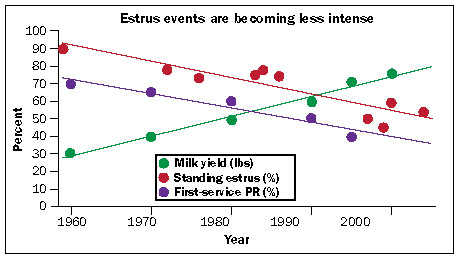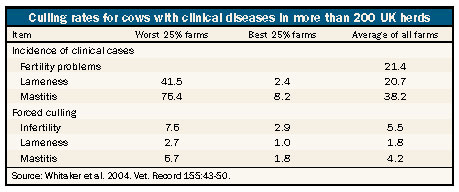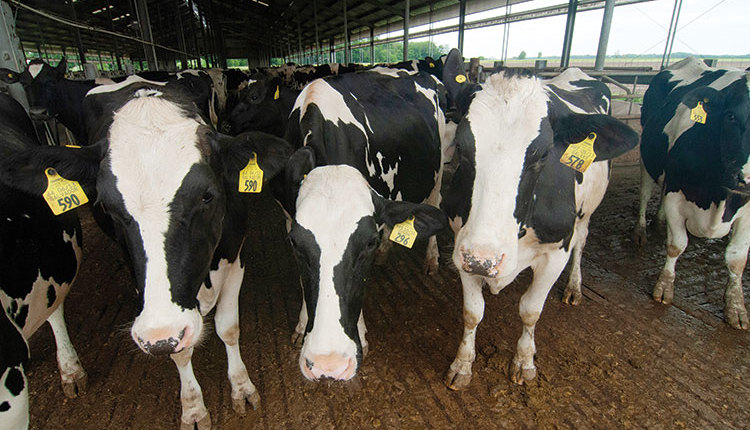The author is professor of animal sciences at Kansas State University, Manhattan.
Is it getting more difficult to successfully A.I. breed dairy cows? That was the question posed by colleagues in a scholarly review of research and history involving A.I. breeding of dairy cows. What follows is a synopsis of their findings and conclusions.
What is meant by "successful"? Many opinions may be offered, but here's my guess from the viewpoint of dairy producers facing the A.I. challenge. Successful means getting as many cows pregnant as possible each and every day of the 365-day breeding season! One assumes in that equation that the genetics of semen employed meets the selection goals of the individual dairy operation. Almost any bull can successfully impregnate cows, but are his genes the desirable DNA to be transmitted to the next generation of replacement heifers?
How can we improve?
What are the factors associated with the greater difficulty in successful A.I. breeding? The most often quoted impediment is the elevated milk volumes produced by today's dairy cow. Numerous studies have documented the negative linkage between higher milk yields and reduced pregnancy rates.
But before you entirely buy into the argument that the sole source of the problem is related to bolstered milk production, take time to go back and read my Artificial Breeding column in November 2011, page 740, "Is fertility really declining?" Let's look at other documented factors, events and changes that have occurred during the past 50 years.
The percentage of cows standing to be mounted and the duration of standing estrus have declined during the last 50 years (see figure). These observations have been coupled with a marked reduction in first-service pregnancy rates and in the amount of farm labor per cow. What is the cause of this downgraded intensity of estrus?
For one, the majority of our dairy cows are housed either wholly or partly on concrete rather than dirt or pasture. According to research in the 1990s, when a cow in estrus has the choice to stand to be mounted on good, dry, well-grooved concrete or on dirt, her choice is dirt 73 percent of the time.
Does that tell us something about comfort and "desire" to stand to be mounted? It is true, however, that high-producing cows, housed in the same herd environment as their less-productive herdmates, stand to be mounted less often and have shorter durations of estrus.

Health equals heat
Several clinical diseases are associated with poor fertility. Cows having less body condition and (or) more negative energy balance early after calving take as many as 10 additional days to establish pregnancy. Cows with low blood calcium (milk fever) take 13 days longer to get pregnant. Days between calving and onset of pregnancy (days open) are extended by least 18, 25 and 31 days for cows treated for metritis, retained placenta or endometritis, respectively, compared with healthy herdmates. Clearly, so-called production diseases take their toll on reproductive efficiency.
Lame cows are less fertile and take more than 40 extra days to conceive even after treatment. Intensity of estrus is 50 percent less in lame cows, and fewer lame cows ovulate. Luteal-phase concentrations of progesterone are also 50 percent less in lame cows, and follicular phase estradiol concentrations are less in nonovulating lame cows compared with ovulating cows. Lame cows fail to have normal LH (luteinizing hormone) surges that lead to ovulation.
What can we do?
Based on a large number of reports, the average incidence of lameness was 15 percent and 27 percent for mastitis. In the UK, the overall incidence of clinical diseases was quite alarming, but the best 25 percent of dairy producers were capable of reducing the impact of clinical disease (see table below).

Preventive measures on the "best" farms were likely more successful in reducing the impact of clinical disease on fertility. On-farm schemes to prevent clinical disease have a positive impact to reduce incidence and improve health. But often, positive effects on fertility are not realized, partly because the disease damage is often done before diagnosis occurs, and many of these diseases are subclinical and go untreated.
Another solution to avoid negative effects of clinical disease on production and fertility could occur through genetic selection. Unfortunately, a 2003 survey of selection practices in 15 countries showed the average relative genetic emphasis for milk yield, durability and health-reproduction traits was 59.5 percent, 28 percent and 12.5 percent, respectively. In other words, more than half of the selection emphasis was focused only on yield.
The largest obstacle to making more genetic progress in health traits is the lack of uniformity in how health and disease are reported in our dairy record systems. Without a uniform method of coding this information for each cow, the animal breeders' ability to calculate the sire's contribution to these health issues is limited.
I encourage our dairy record processing centers and animal breeders to find ways to standardize and uniformly gather health data. If this can be done, the effects of A.I. sires on health traits and fertility can be sorted out and lead to some reasonable estimates of health or disease PTAs for our proven-sire population.
Is it getting more difficult to successfully A.I. breed dairy cows? That was the question posed by colleagues in a scholarly review of research and history involving A.I. breeding of dairy cows. What follows is a synopsis of their findings and conclusions.
What is meant by "successful"? Many opinions may be offered, but here's my guess from the viewpoint of dairy producers facing the A.I. challenge. Successful means getting as many cows pregnant as possible each and every day of the 365-day breeding season! One assumes in that equation that the genetics of semen employed meets the selection goals of the individual dairy operation. Almost any bull can successfully impregnate cows, but are his genes the desirable DNA to be transmitted to the next generation of replacement heifers?
How can we improve?
What are the factors associated with the greater difficulty in successful A.I. breeding? The most often quoted impediment is the elevated milk volumes produced by today's dairy cow. Numerous studies have documented the negative linkage between higher milk yields and reduced pregnancy rates.
But before you entirely buy into the argument that the sole source of the problem is related to bolstered milk production, take time to go back and read my Artificial Breeding column in November 2011, page 740, "Is fertility really declining?" Let's look at other documented factors, events and changes that have occurred during the past 50 years.
The percentage of cows standing to be mounted and the duration of standing estrus have declined during the last 50 years (see figure). These observations have been coupled with a marked reduction in first-service pregnancy rates and in the amount of farm labor per cow. What is the cause of this downgraded intensity of estrus?
For one, the majority of our dairy cows are housed either wholly or partly on concrete rather than dirt or pasture. According to research in the 1990s, when a cow in estrus has the choice to stand to be mounted on good, dry, well-grooved concrete or on dirt, her choice is dirt 73 percent of the time.
Does that tell us something about comfort and "desire" to stand to be mounted? It is true, however, that high-producing cows, housed in the same herd environment as their less-productive herdmates, stand to be mounted less often and have shorter durations of estrus.

Health equals heat
Several clinical diseases are associated with poor fertility. Cows having less body condition and (or) more negative energy balance early after calving take as many as 10 additional days to establish pregnancy. Cows with low blood calcium (milk fever) take 13 days longer to get pregnant. Days between calving and onset of pregnancy (days open) are extended by least 18, 25 and 31 days for cows treated for metritis, retained placenta or endometritis, respectively, compared with healthy herdmates. Clearly, so-called production diseases take their toll on reproductive efficiency.
Lame cows are less fertile and take more than 40 extra days to conceive even after treatment. Intensity of estrus is 50 percent less in lame cows, and fewer lame cows ovulate. Luteal-phase concentrations of progesterone are also 50 percent less in lame cows, and follicular phase estradiol concentrations are less in nonovulating lame cows compared with ovulating cows. Lame cows fail to have normal LH (luteinizing hormone) surges that lead to ovulation.
What can we do?
Based on a large number of reports, the average incidence of lameness was 15 percent and 27 percent for mastitis. In the UK, the overall incidence of clinical diseases was quite alarming, but the best 25 percent of dairy producers were capable of reducing the impact of clinical disease (see table below).

Preventive measures on the "best" farms were likely more successful in reducing the impact of clinical disease on fertility. On-farm schemes to prevent clinical disease have a positive impact to reduce incidence and improve health. But often, positive effects on fertility are not realized, partly because the disease damage is often done before diagnosis occurs, and many of these diseases are subclinical and go untreated.
Another solution to avoid negative effects of clinical disease on production and fertility could occur through genetic selection. Unfortunately, a 2003 survey of selection practices in 15 countries showed the average relative genetic emphasis for milk yield, durability and health-reproduction traits was 59.5 percent, 28 percent and 12.5 percent, respectively. In other words, more than half of the selection emphasis was focused only on yield.
The largest obstacle to making more genetic progress in health traits is the lack of uniformity in how health and disease are reported in our dairy record systems. Without a uniform method of coding this information for each cow, the animal breeders' ability to calculate the sire's contribution to these health issues is limited.
I encourage our dairy record processing centers and animal breeders to find ways to standardize and uniformly gather health data. If this can be done, the effects of A.I. sires on health traits and fertility can be sorted out and lead to some reasonable estimates of health or disease PTAs for our proven-sire population.
This article appears on page 659 of the October 10, 2012 issue of Hoard's Dairyman.







